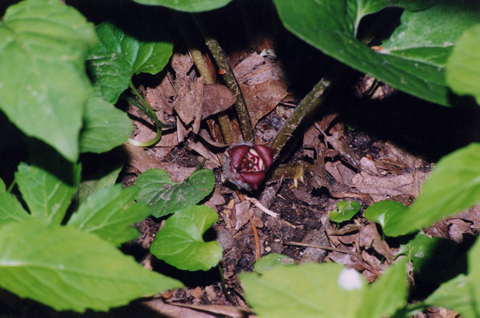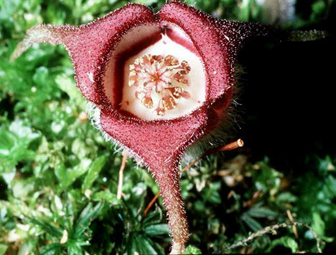Lewis reported that a specimen of this plant “was taken the 1st of June at the mouth of the Osage River; it is known in this country by the name of the wild ginger, it resembles that plant somewhat in both taste and effect; it is a strong stomatic stimelent, and frequently used in sperits with bitter herbs— it is common throughout the rich lands in the Western country.” He shipped the specimen back east from Fort Mandan in April 1805 as item No. 10 in his inventory of plants collected on the Mississippi and Missouri rivers. His list included “such observations on the vegitable kingdom spread to our view in this rich country as they have occurred to my mind.– or as the several subjects have presented themselves to my view.”[1]Moulton, Journals, 3:451, 453. The shipment was received by John Vaughan at the American Philosophical Society in November 1805 and forwarded to Benjamin Smith Barton for study. Sometime between 1805 and 1807 this specimen, along with all of those numbered 1 through 30 by Lewis, disappeared. Frederick Pursh, who examined Lewis’s plants, apparently never saw any of those, and the only record is what appears in Lewis’s list. Even so, in the 1980s one of the labels came to light at a Philadelphia flea market when it was sold as a Lewis autograph. Perhaps those first thirty plant specimens from the Lewis and Clark expedition still exist in some unknown attic or basement.
The generic name Asarum is the Latin form of asaron, the Greek name for wild ginger. The initial L. following the binomial stands for Carl Linnaeus, who formally published the name in Species Plantarum 1:442 (1753), with the provenance, “Habitat in Canada.” The combination of the two words, Asarum and canadense were first applied to the species by a French naturalist in 1635. The species was collected early in the eastern North American colonies and taken to Europe in the late 1500s as a medicinal plant. There it was fairly common in gardens, and is mentioned in several 17th-century medical books as an herbal. It was once used by many different Indian tribes for a wide variety of physical–and even psychological–ailments,[2]Daniel Moerman, Native American Ethnobotany (Portland, Oregon: Timber Press, 1998), 105-06. but it has not been proven to have any real therapeutic value. Also, although some Indians employed its root as a food flavoring, the plant is not related to the common garden ginger used in the kitchen today, Zingiber officinale Roscoe. (The generic name Zingiber came from a Sanskrit word meaning “horn-shaped,” in reference to the bumps on its root. It was given its scientific binomial by the English botanist William Roscoe in 1807.)
Wild ginger is occasionally sold as a medicinal plant even today, although its use for any illness is questionable, and its long-term use is dangerous.
Notes
Experience the Lewis and Clark Trail
The Lewis and Clark Trail Experience—our sister site at lewisandclark.travel—connects the world to people and places on the Lewis and Clark Trail.
Discover More
- The Lewis and Clark Expedition: Day by Day by Gary E. Moulton (University of Nebraska Press, 2018). The story in prose, 14 May 1804–23 September 1806.
- The Lewis and Clark Journals: An American Epic of Discovery (abridged) by Gary E. Moulton (University of Nebraska Press, 2003). Selected journal excerpts, 14 May 1804–23 September 1806.
- The Lewis and Clark Journals. by Gary E. Moulton (University of Nebraska Press, 1983–2001). The complete story in 13 volumes.



